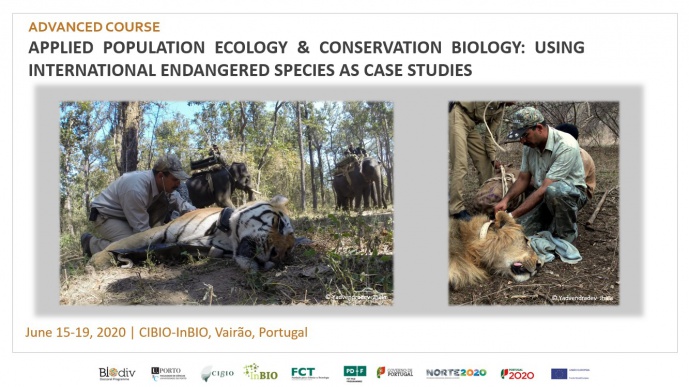Applied population Ecology & Conservation Biology: using international endangered species as case studies (CANCELLED)

Course Content:
Main topics include: Wildlife conservation, Population Ecology, Large Scale Surveys and Status Assessment, Human-Wildlife Conflict, Aspects of animal behaviour.
Examples of international conservation and research focused on endangered fauna from India, such as tigers, Asiatic lions, Indian wolves, Golden jackals, Great Indian Bustard, & Greater One Horned Rhinoceros, shall be used to address the above concepts of Population Ecology and Conservation Biology.
Previous knowledge:
No advance knowledge is required, course can be attended by biology graduates interested in wildlife science and conservation. Course will be useful for higher level students in Population Ecology & Conservation Biology or for those planning a PhD on these topics. Doctoral students who have already collected field data would benefit from analytical techniques.
Learning outcomes:
Students will learn theory about wildlife conservation, population ecology, animal behaviour and conservation genetics applications in wildlife conservation and management. With a focus on large carnivore and endangered species research, they will learn about practical implementation of these methods for effective conservation. Students will learn about aspects of animal abundance estimation, large scale surveys, status assessment techniques, international conservation problems and prospects; understand concepts of Minimum Viable populations (PHVA), habitat corridors and the role of dispersal with real life examples. Students will get an idea of incorporating science into conservation policy and planning.
Students will become familiar with Population Modelling, Animal Abundance Estimation (Distance sampling, Occupancy modelling, Capture Mark Recapture, Spatially Explicit CMR, Survival Analysis and Population Viability Analysis).
Teaching and learning method
Lectures, class exercises, and student seminars based on relevant papers in the above subject areas that will be read and presented by the students for discussion in the class.
Assessment
Grading is based on participant’s contribution during the classes, student seminar, and paper presentation. Topic seminars will be presented by students in groups. Relevant papers will be circulated with the students a week in advance for preparation of seminar presentations.
COURSE INSTRUCTOR
Dr. Yadvendradev Jhala - Wildlife Institute of India, Dehradun, India
INTENDED AUDIENCE
The course will be open to a maximum number of 20 participants.
PROGRAMME
Day 1- Introduction– Population Ecology, Definitions, Population Growth, Life Tables, Carrying Capacity, Island Biogeography, Metapopulation, Reserve size and design, Source-Sink dynamics, & their implications to endangered species management. . Population viability analysis with real life examples (tigers, Asiatic lions, greater one horned rhinoceros), movement corridors, importance of harvest (poaching) and movement corridors on species persistence. Example of modelling and management of tiger corridors in India. Student seminar on related publications.
Day 2- Population assessment methods: Species Occupancy, Capture-Mark-Recapture, work with real life data using software PRESENCE & MARK. Student Seminars on related publications, practical exercises
Day 3- Distance Sampling & Spatially Explicit Capture Recapture. Sampling designs, data collection, & analysis using DISTANCE. Large scale population status assessment – example of Indian tiger status assessment, Asiatic lion assessment, and their implications for species conservation (policy and management). Student Seminars on related publications, practical exercises - continue with software and data of day 2-3.
Day 4- Open Population models and Known Fate Models – survival estimation examples in MARK. Real life data analysis using tiger, lion & rhino datasets. Student Seminars on related papers. Student Seminars on related publications and work with Distance, Mark, Presence – problem solving
Day 5- Morning: Practical Exercise in PHVA using VORTEX. Seminars on related publications.
Afternoon: Open seminar in CIBIO about "Conserving the Great Indian Bustard” (45 min presentation + 15 min discussion)
Schedule:
Monday-Thursday: 9h.30 to 17h.30 (with one hour lunch break 13:00-14:00 hrs)
Friday morning: 9h.30 to 12h.30
Friday afternoon: Open seminar with aprox. 1h duration
Total Course duration: 31 hours
SELECTION CRITERIA
75% of available student slots are reserved for BIODIV students.
Priority will be given to:
• 1st year and other PhD students attending the BIODIV Doctoral Program;
• PhD students attending other courses;
• Other post-graduate students and researchers.
REGISTRATION
Participation is free of charge for BIODIV students | 95 € (students) | 200 € (other participants). CIBIO-InBIO members will have an additional discount of 20%.
Please note that new rules apply for all BIODIV students.
